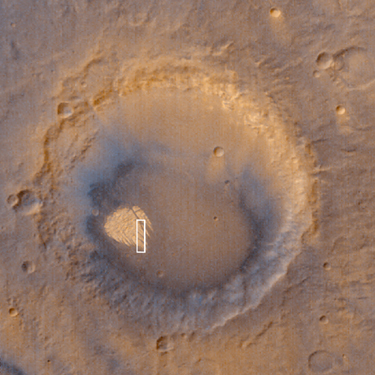
"White Rock" is a ridged mound that was first seen and informally named "White Rock" in pictures from the Mariner 9 orbiter in 1972. In black-and-white photos, the feature appears much brighter than its surrounding terrain, giving the impression that the material is white. Later analyses of Mariner 9, Viking, and Mars Global Surveyor (MGS) data showed that the feature isn't actually white, it is somewhat red and reflects only about 20-25% of the sunlight that falls upon it (a white surface would reflect 100%).
Located in Pollack Crater, a 95 km (59 mile) wide impact basin at 7.9°S, 334.7°W, White Rock is the light-red/orange feature with the rectangular white box drawn on it in the context view above. The white box indicates the location of a sub-frame of a MGS Mars Orbiter Camera (MOC) image acquired in September 2000, shown in PIA02848. The light-toned material that gives White Rock its name forms steep cliffs with valleys between them covered by dark, windblown, rippled sand. This release image shows a close-up of a portion of PIA02848, illustrating that the bright material is layered (arrow, "layers") and that there is an old impact crater (arrow, "crater") that has been partly uncovered from beneath the White Rock material.
The layering in White Rock suggests that the material is sediment deposited at some time in the distant past within Pollack Crater. The fact that the material erodes to form steep cliffs suggests that it is hard like rock. Thus, White Rock is interpreted to be an outcrop of sedimentary rock. It is probably a small remnant of a larger body of rock that may have once covered the entire floor of Pollack Crater; this view is supported by the observation that more extensive layered rocks are seen in other craters across the surface of the red planet (e.g., the crater at 8°N, 7°W).
Both pictures shown here are illuminated by sunlight from the upper left, north is up. Pollack Crater was named in 1997 for James B. Pollack (1938-1994), a NASA Ames Research Center scientist known in the Mars research community for his atmospheric research with Mariner 9 and Viking data and the development of key computer models used to investigate the red planet's winds, storms, and climate.

 Planetary Data System
Planetary Data System













